In the right terms, “Sialia” is the Latinized, neuter plural version of the Greek word sialis, a noun meaning a “kind of bird.” The Eastern Bluebird (Sialia sialis) was the first bluebird classified by Carolus Linnaeus in 1707–1778. He gave it the species name Sialis, though he placed it in the genus Motacilia which is now reserved for the wagtails. It was William Swainson (1789–1855) who, in 1827, decided that the bluebirds needed a genus of their own within the thrush family (Turdidae).
He selected the generic name “Sialia,” which he simply adapted from the species name Sialia that Linnaeus had used. Therefore, the scientific name for the Eastern Bluebird is Sialia sialis. Similarly, the Western Bluebird and Mountain Bluebird, the two other species within the genus, were named Stellemexieana and Sialia currucoides, respectively.
Their species’ names are descriptive of their locations. All three bluebird species are native to only 10 percent of the North American continent, although each inhabits different regions generally separated by the Rocky Mountains and by altitudinal preferences. While the adult birds all show differing plumages, the young of all three species look remarkably alike, prominently displaying spotted breasts and large white eye-rings.
This similarity in plumage was the principal reason the society chose the juvenal bluebird for its logo. Since bluebirds almost always choose to raise their young in small, enclosed cavities, a young bluebird sitting near a nesting box seemed to symbolize our mission. The hope of any species resides in its young. Because of bluebird nesting preferences, the survival of their young may depend on the nesting box, especially since natural cavities, for a variety of reasons, are disappearing rapidly.
The theme of bluebirds young nurtured in man-made structures will be a recurring one in our art and literature. We hope that this theme will remind all about the plight of the bluebird and will stimulate action which will allow this beautiful creature to prosper. For many years bluebirds have been in trouble trying, usually in vain, to maintain their population.
Various factors have been involved in the bluebird population decline, but the principal causes are believed to be a shortage of the natural cavities they require for nesting plus severe co-petition from the alien House Sparrows and European Starlings for the most available cavities. Consequently, efforts to help the bluebird have been confined largely to supplying them with nesting boxes mounted in suitable habitats and trying to protect the birds during the nesting season from their natural and imported enemies.
Public concern over the plight of the bluebird has increased enormously in recent years. Hundreds of people have become actively involved in helping these beautiful birds and many thousands of bluebird nesting boxes have been erected throughout the United States and Canada. A brief review of some of the important milestones in the bluebird conservation effort should, therefore, be of interest.
Before the advent of the white man in North America, American Indians were said to have erected hollowed-out gourds in their Villages to attract Purple Martin s. The purpose was evidently to help control objectionable flying insects since martins consume large numbers of such insects. Hollowed-out gourds are still used to attract martins, particularly in some parts of the South.
Since bluebirds frequently use these gourds for nesting, it is assumed that they also used some of the gourds supplied by the Indians before any Europeans settled in America. This then probably represents the beginning of the custom of attracting bluebirds by supplying artificial nesting sites.
In early Colonial times, the Eastern Bluebird is known to have been much admired and was often called the ” blue robin ” since it reminded the colonists of their beloved European Robin. The bluebird gradually became a symbol of love, hope, and happiness.
This symbolism persists today. Through the years, the bluebird has been mentioned more frequently than any other bird in American poetry and in the lyrics of our popular songs. It seems probable that some of the early colonists attracted bluebirds close to their homes with nesting boxes of some sort, although the document at the end of this is obscure. Listen here to the one-hour beautiful song of the eastern bluebird.
The bluebirds were very active, flying about, eating weed seeds, catching insects, walking about on the ground and gravel road, and even perching on top of the air vent of the buried gas tank. They were only a short distance from the truck, often only a few feet from it. It was a very enjoyable lunch hour for both of us.
A nesting box mounted six feet or more above the ground on a smooth metal pole, such as a piece of galvanized water pipe, and located 75 feet or more from any wooded area is unlikely to be of any interest to flying squirrels. These beautiful little animals feel at home only in or very close to the woodlands.
If the mounting pole is kept covered with soft automobile grease during the nesting season the box will be still better protected from squirrels and most other climbing predators.













